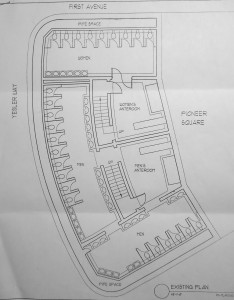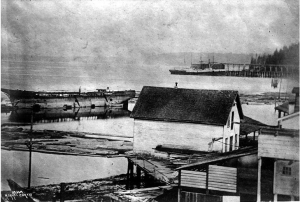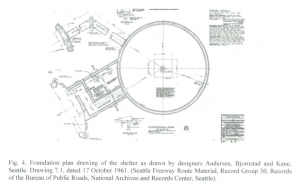With all of Seattle baffled by Bertha, and the answer to what’s stopping her apparently not forthcoming any time soon, I thought I’d look at a few known features that lurk below the city surface, and that Bertha could encounter if she takes a the wrong turn. Each is then correlated with I call the BerthaControl Factor, or amount of effort it would take Bertha to bust on through to the other side.
Information for these items comes from research for my new book, Too High and Too Steep: Reshaping Seattle’s Topography.
1. The Queen Mary of Johns – Called by some the most luxurious underground toilets in the world, this public restroom opened in 1909, directly under Pioneer Place. Built to accommodate 10,000 flushers a day, it had stall walls of Alaskan marble, with terrazzo and white tile covering the floor and walls. There were ante-rooms for men and woman with oak armchairs. For dime you could get your shoe shined. Men could also buy cigars. Air was ventilated through pipes built into the elaborate structure we call the Pergola, which was designed to make the restroom below cleaner and brighter.
After the restroom opened, an article in the Pacific Builder and Engineer opened with the following statement. “The man of travels will find nowhere in the Eastern hemisphere a sub-surface public comfort station equal in character to that which has recently been completed in the downtown district of Seattle; and in the United States there are very few that will be found to equal it.”
The restroom has been closed for years, though periodically people try to reopen it.
BerthaControl – Four – Bertha wasn’t designed to go through porcelain toilets so she might have gotten clogged up here.

2. The Windward – On December 30, 1875, the 161-foot-long, three-masted ship Windward ran aground in the fog on Whidbey Island’s Useless Bay carrying a load of lumber bound for San Francisco. James Colman then acquired the ruined ship (the owner owed him $800) and had it towed to Seattle, where it was beached on the shorefront. By 1887, when a railroad trestle was being built across the waterfront, the ship had become a husk with all valuables stripped away and no masts. Today, the hull sits where Colman left it on the waterfront, buried somewhere under modern pavement. The best guess is in the vicinity of the corner of Western Avenue and Marion Street, though no evidence of the Windward has appeared in any recent building projects.
BerthaControl – One – Bertha would have whipped through this in no time.

Photo from UW Special Collections
3. Coal Cars in Lake Washington – In the 1870s, coal was starting to become an important export from Seattle. To get the coal to Seattle from its source near modern day Newcastle, it was ferried across Lake Washington to the land separating Lake Washington and Lake Union, portaged across this divide, put back on a boat to cross Lake Union to a terminal, where Seattle’s first train carried it down to a coal bunker at the base of Pike Street. In January 1875, a small stern-wheeled steamboat, the Chehalis, was making the run across Lake Washington when a storm tipped the barge carrying 18 railroad cars full of coal. The cars were discovered by Robert Mester. They sit in the middle of the lake, a bit south of the 520 floating bridge.
BerthaControl – Three – Steel, wood, and coal would have slowed down Bertha, though probably not for long.

Photo from Emerald Sea Photography web site
4. Submerged Forests – Around 1,100 years ago, three groves of trees slid into Lake Washington. The trigger was an earthquake on the Seattle Fault, which runs from the eastern edge of Bainbridge Island through the Duwamish tidal flats and under Lake Washington and Lake Sammamish. The forests now sit in 90 feet of water. One stand is off the southeast corner of Mercer Island. Another settled on the west side of the island, across from the south end of Seward Park, with the third landslide between Holmes Point and North Point near St. Edward Park, north of Kirkland.
When divers explored the trees in 1957, they discovered that many were still upright and appeared to have slid to their present position with little movement relative to the soil where they had grown. The largest had a circumference of over 28 feet and the longest measured 120 feet with a 5.5-foot diameter. They were so waterlogged that they sank readily.
After the Lake Washington Ship Canal opened in 1916, the Army Corps of Engineers had to blow up some of the trees because their tops were too close to the surface; the Corps worried that boats might run into the trees.
BerthaControl – Three plus – These are some big old trees dense with water, plus it’s unclear if Bertha was designed to deal with spongy stuff.
5. Weedin Place Fallout Shelter – During the height of the Cold War in 1963, the federal government paid for a nuclear fallout shelter to be built under I-5. An article in the Fall 2011 Journal of Northwest Archeaology (vol. 45, no. 2) by Craig Holstine describes it as a “prototype community” shelter “virtually bereft of style, designed for survivabilty rather than elegance or comfort.” Planned to hold 200 people for two weeks, it had diesel-powered electricity generator, an air circulation system, a well, and piping connecting the shelter to the city’s water and sewer systems. Beds were triple-level bunks divided by sex and/or family. Holstine also notes that the shelter was later used for storing records from the Washington Department of Transportation and for issuing drivers licenses. The shelter is located on Weedin Place, just north of the Ravenna Park and Ride.
BerthaControl – Five – If the shelter could stop nuclear fallout, surely it could stop Bertha.

Drawing from Journal of Northwest Archaeology
Shame on you for calling a head, a can, a restroom, a bivvy, an outhouse, a JOHN!
I remember getting a driver’s license renewed at the shelter at Weedin Place. What’s happening to it now?
Where is BerthaControl Two?